On the occasion of our exhibition Purpose (July 9-August 21, 2025), we spoke with select artists about their work.
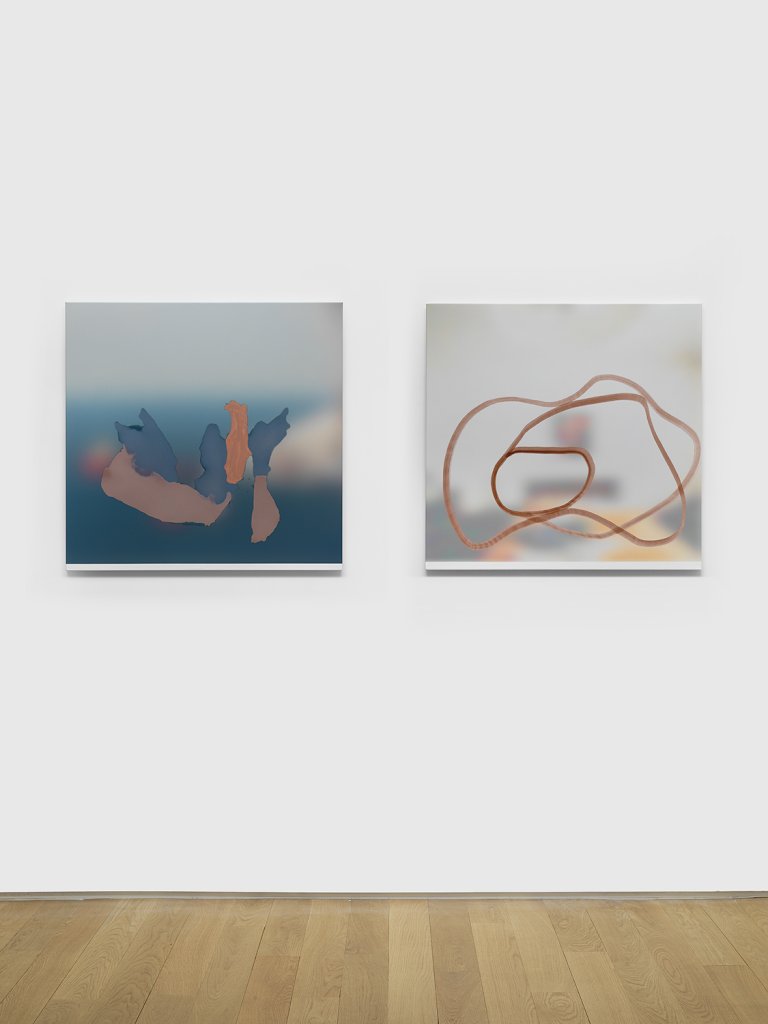
Installation view of Mauro Bonacina’s work in Purpose (July 9-August 21, 2025) at Alexander Berggruen, New York.
Q: Would you like to discuss one other artwork in this group show that you feel especially invites a conversation with your work?
A: I would like to talk about the Richard Prince Cowboy series as a whole. In both his and my work, the subject matter and the conceptual idea live in symbiosis. The conceptual idea is more interesting and more important to me than the craft behind the making of the painting. Considering the notion of the image being a painting and painting being an image, I think about the Marlboro man pictures as paintings.
To re-photograph a photograph is to take ownership of something that was already existing, the readymade. It is almost quoting the medium that is already existing.
What interests me about the Richard Prince is the selection of the image and the content of the image which can be used as a type of signifier. In this case, of course it’s a conceptual one, and it can signify Americanism and masculinity. Without really revealing too much, it acts as a door that opens this narrative, quite specifically and quite insightfully. When taking the photograph of a photograph, Prince is editing the image through his decisions to crop out the branding and advertisement. This makes it almost a painting in the way that I approach painting.
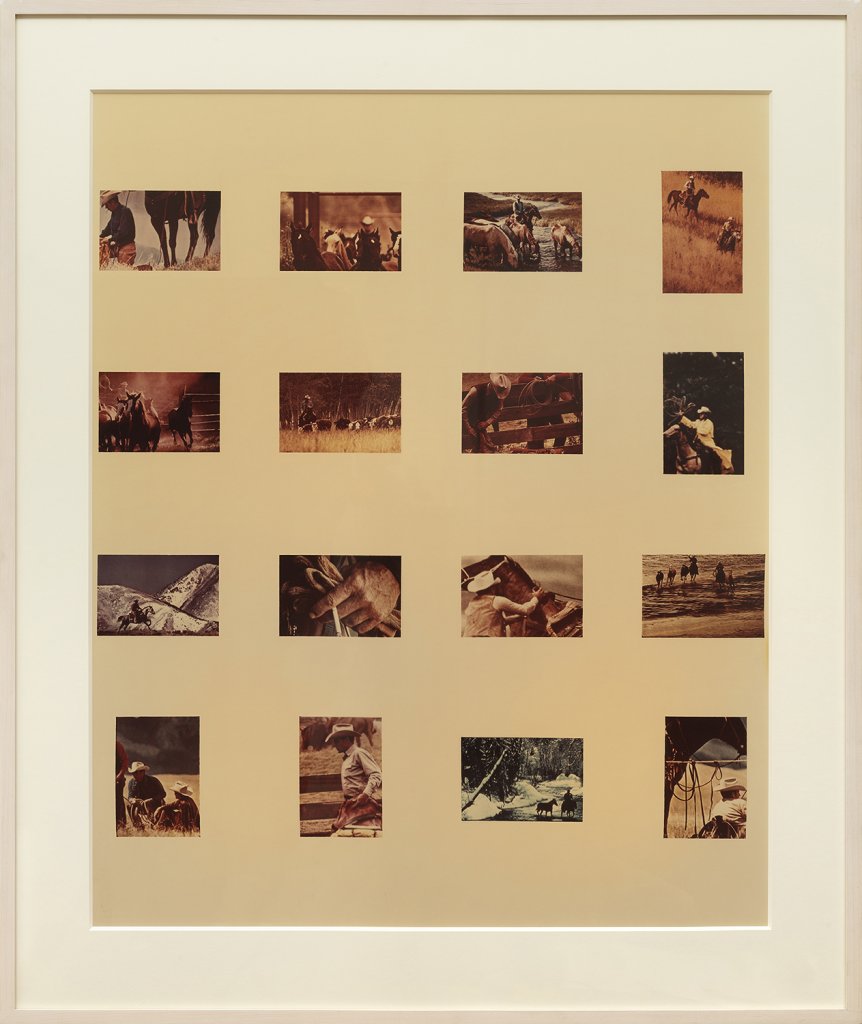
Richard Prince
Untitled (Cowboys), 1984
ektacolor photograph, framed
36 x 29 in. (91.4 x 73.7 cm.)
frame: 44 x 37 in. (111.8 x 94 cm.)
edition AP from edition of 2 plus 1 AP
Courtesy of Skarstedt, New York
Q: How do you approach painting?
I’m interested in the conceptual idea of what painting can be. Because of market conditions or trends now, we aren’t giving much importance to wanting to push the language forward and think about painting as a valid medium within contemporary art.
If we are to think about painting much more conceptually, and still of course, allow it to exist within the parameters that do make a painting a painting, then I’m less interested in showing off my skill (which already is a weird word for me), I’d much rather think about the language, the aesthetic language that makes a painting a painting today. How can I question what it is and what it can be today, in this world where images are mass-produced and so easily available and consumed so quickly and fake or not fake?
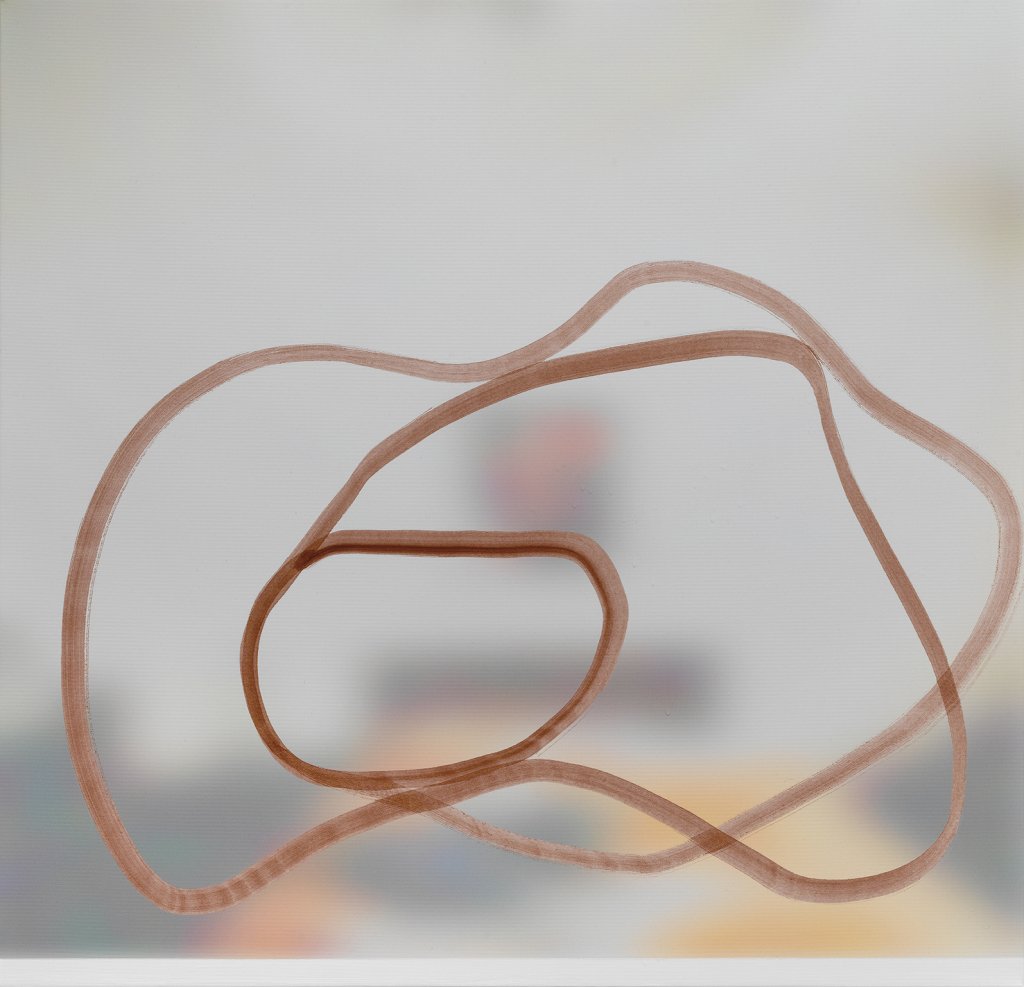
Mauro Bonacina
Sunglasses, Advil and Daddy Issues, 2025
airbrush ink, acrylic, and UV ink on canvas
34 1/4 x 35 3/8 x 1 in. (87 x 90 x 2.5 cm.)
Q: Looking closely at your painting Sunglasses, Advil and Daddy Issues, you have rendered trompe-l’œil water drips on top of the canvas. Could you share some insight into how these drips came to be?
You refer to them as tromp l’oeil but it’s actually funny because they’re not. They’re actually an acrylic medium, which is like see-through paint. I find that funny in itself, to make these drips and make them look almost as if they were tromp l’oiel water drips or just a painting accident, which only happens through the act of painting. They came about because within the balance of that picture, I like the idea of the brushmark not being made by a brush. That sort of wiggly thing in the center of the painting is printed. Not that it’s important to me anyway to define that for a viewer.
The drips were a signifier to refer to something that was handmade. The painting action—a drip, a brushstroke—acts as a conceptual element. To balance the picture, it needed some kind of disruptor. The drip acts as a disruptor, even though the awkward wiggly line on top of this sort of perfectly smooth sprayed background already counted as that, but this was the bridge between that wiggly line and the background.
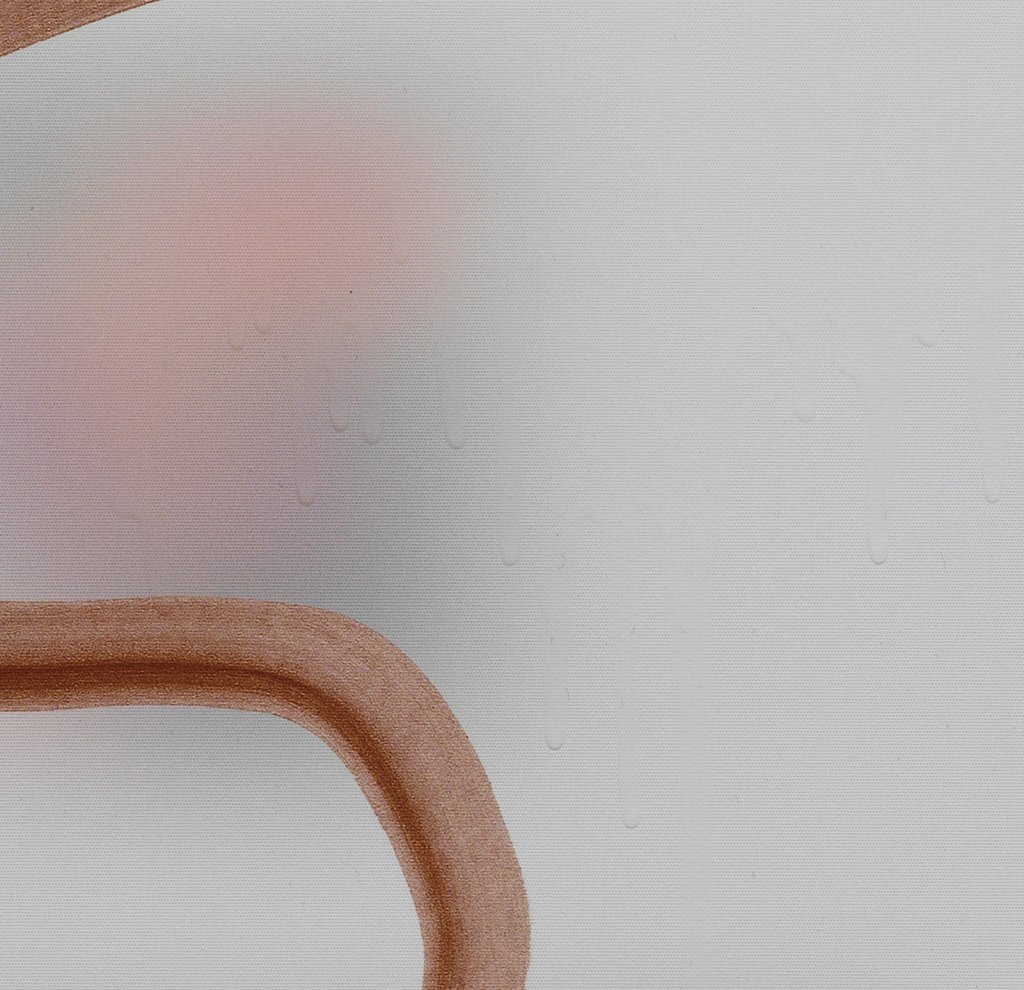
Mauro Bonacina
detail of Sunglasses, Advil and Daddy Issues, 2025
airbrush ink, acrylic, and UV ink on canvas
34 1/4 x 35 3/8 x 1 in. (87 x 90 x 2.5 cm.)
Q: You stated: “Recently I started thinking about the brushmark as an image,” and I was hoping you could expand on that further.
A: It took me to thinking about painting as an image in a way I hadn’t before. A painting can be an image of a painting, but also an image can be a painting in itself. All of the sudden, mixing the idea that an image of a brushmark is just as valid, and an image by itself is just as valid as a painting depending on which way we decide to depict it or which way we decide to display it. Having this element where an extra logic would be employed to connect the two—meaning what image you choose, how you choose to abstract it to create further meaning—now is also combined with which human mark I would choose, you know, a brushmark I can take. The minute you see it as an image, you can take a puddle from the floor. You can take some drips from DIY, you can take from street art, you can take from a children’s book, you can take from a very famous painting. All these things that I’ve always been attracted to and could never really make sense of it all as one. Even though I’ve always been sampling images, I didn’t realize that I could actually make paintings that were sampled paintings, if that makes any sense.
Q: You recently completed a 10 year project on Instagram where you posted a new image every day related to the one you posted the day before. As your paintings and this Instagram project rely heavily on your library of images, how do you determine when an image is worthy of being added to your library and subsequently used in your work?
A: When it comes to these two works, we can talk about the type of images I choose and the type of interventions I take, or the type of interventions that I choose to take and edit from – the paintings or from other gestures that occur in my life. I’d rather not tell exactly what they are and why they are, but we know as from previous examples of my work, a lot of the majority of the images come from a library of images that I’ve collected, things that I’ve downloaded mainly from the internet, but now I’ve been able to enlarge my thinking, and the possibilities have multiplied. It’s also been interesting to look closer at images that I can take myself of something else, be it an image of a brushmark on a painting or an image of a puddle. It also could be an image on my phone which inevitably is such a common library for everybody to have on a daily basis. Of course, it has to make sense to me or it has to be a signifier for something that acts on more than one level for me to choose it and edit it and throw it in the mix. There’s definitely an element where I’ve selected a certain type of image, and in this specific instance, I have paired it or I have juxtaposed it with another image which resembles more a painterly intervention. Then, the logic within creates a further logic or leaves a trace or a map for a certain logic or narrative, visual or linguistic narrative to stimulate the viewer to be able to engage with and believe this world, the narrative I’m trying to create. I think the works should speak for themselves.
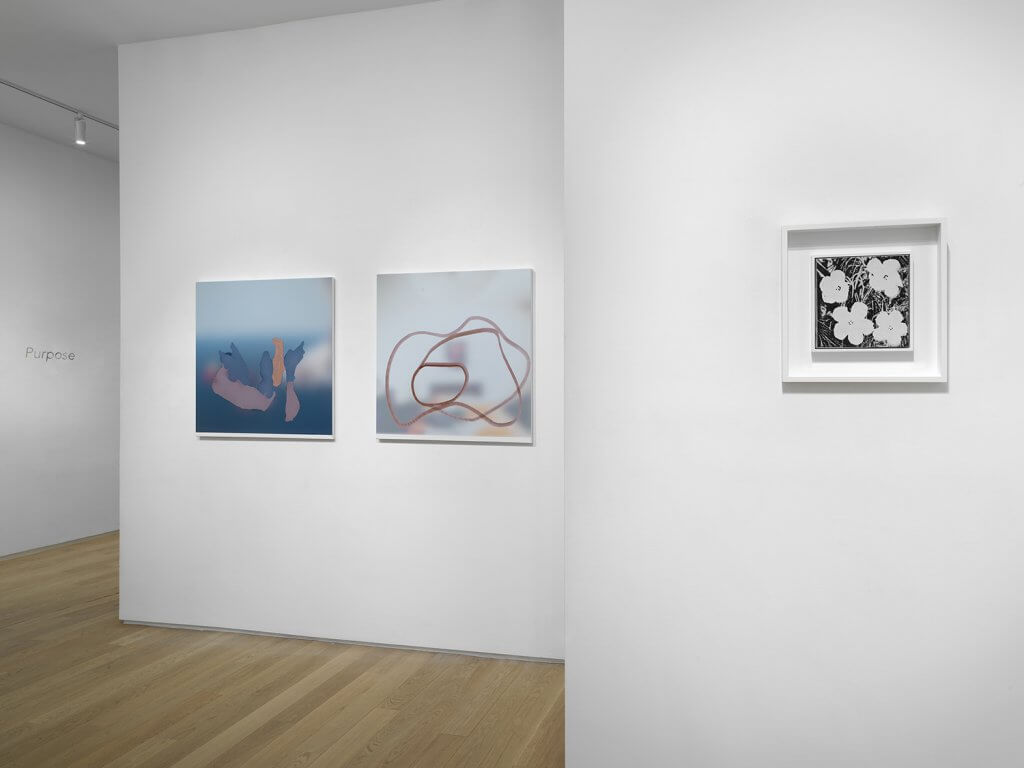
Installation view of Purpose (July 9-August 21, 2025) at Alexander Berggruen, New York.
Q: How would you describe your process of arriving at these paintings?
A: I develop custom tools and techniques that blend painting, printmaking, and fabric-based methods. In these paintings, I weave across the surface of the canvas and use handpainting, rolling, and airbrushing to index the impressions of textiles. I layer different sizes of ribbon and yarn that loop, interlace, and generate tension that both create structure and unravel.
Each composition comes together through this layered process that feels both intuitive and deliberate. I follow a kind of print and textile logic – where a small shift in one area can ripple through the whole piece. This way of working reminds me of how systems in nature behave – like webs, neural pathways, or even quantum networks – where every thread is connected, and a single movement can stir something elsewhere. I want the compositions to feel suspended in motion, and in a constant state of flux.
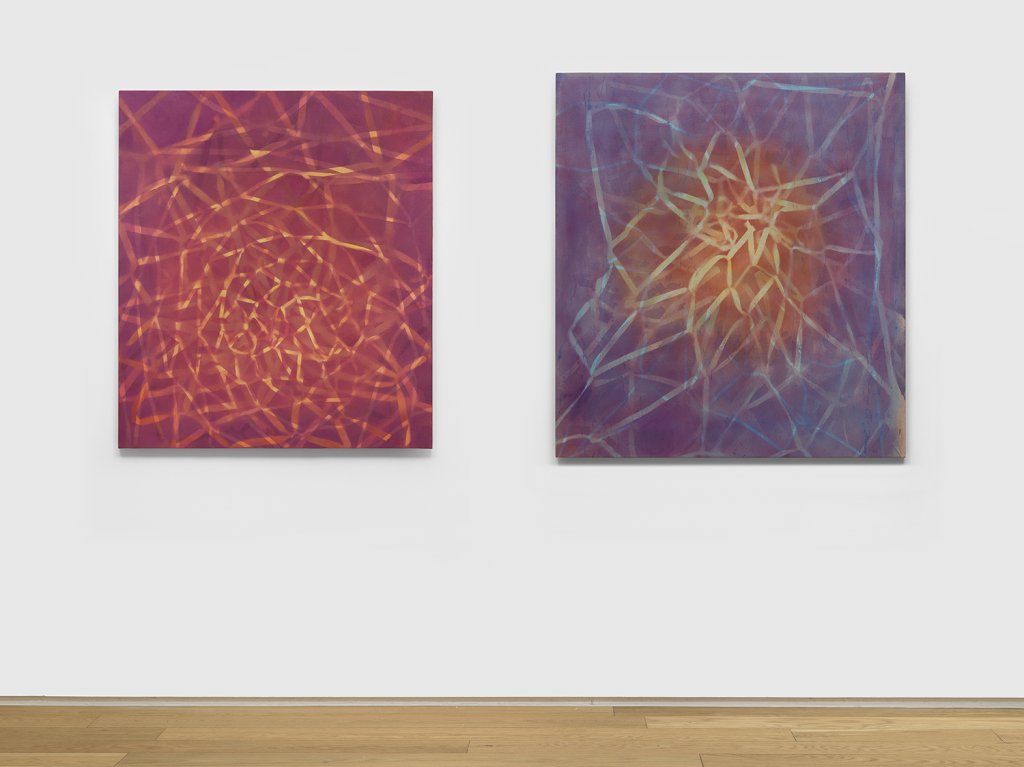
Installation view of Patricia Orpilla’s work in Purpose (July 9-August 21, 2025) at Alexander Berggruen, New York.
Q: You stated that the forms in your paintings in this show “echo string figures, woven patterns, and microcosmic systems.” Could you describe how you envision these structures in the two paintings in this group show Internal Bloom and Warm Recollection?
A: Internal Bloom is inspired by the tension and interdependence found in structures like string figures, spider webs, and basket weaving. Each layer loops and interlocks with the next, forming a system that aims to be both deliberate and organic. A warm light source pulses from the center, illuminating lines moving in a slow bloom. Though the source of this glow is ambiguous, it gestures toward an inner vitality – something felt more than seen, like joy, memory, or stored experience within the body. The composition mimics natural systems of growth and repair, mapping the invisible through visible form. I’m interested in how these patterns echo what we carry internally – how the body remembers tension, warmth, and connection across time.
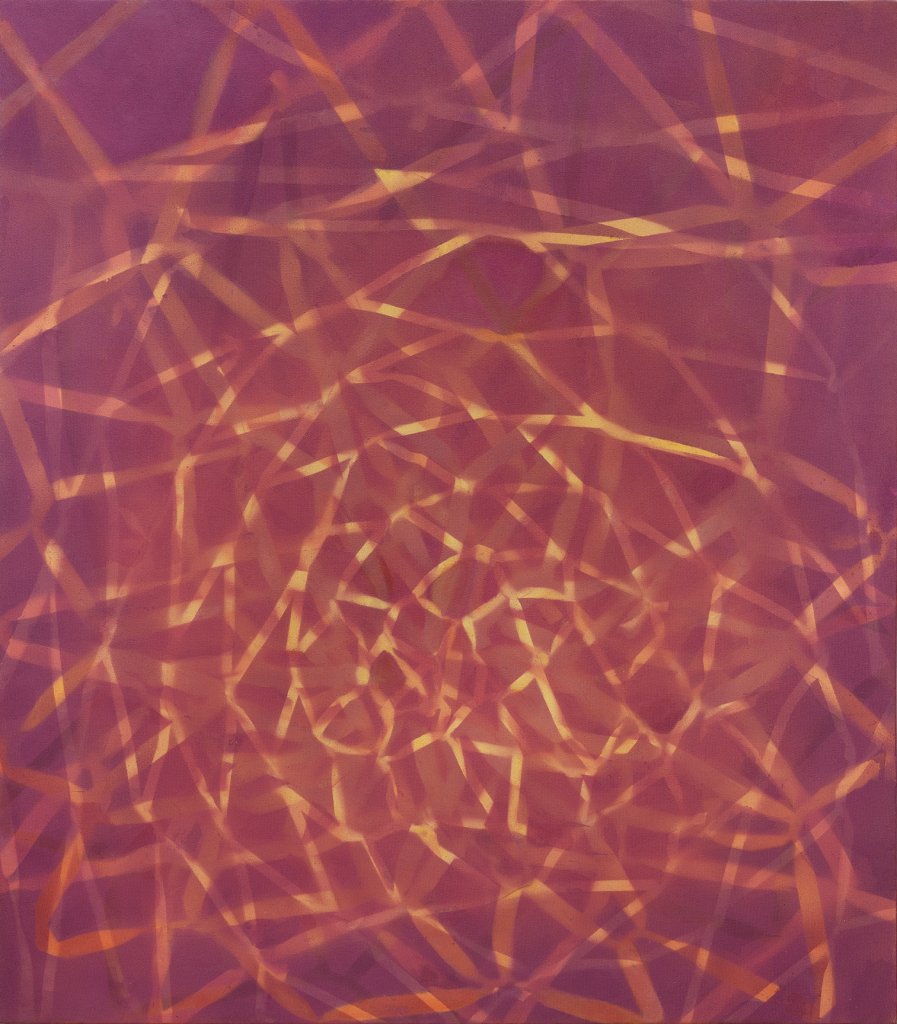
Patricia Orpilla
Warm Recollection, 2025
dye and acrylic on canvas
48 x 42 in. (121.9 x 106.7 cm.)
Warm Recollection reflects on memory as both a spontaneous, human experience and a biological function shared across species. The structure of the painting evokes neural networks, plant growth patterns, or woven forms – systems that register and adapt to past events in order to survive or flourish. The warm palette speaks to the possible feeling of recollection – the way a memory can surface unexpectedly, triggered by a feeling, a scent, or an experience of light. It also gestures towards the intelligence of living systems, where memory isn’t stored in images or language, but in form, response, and repetition.
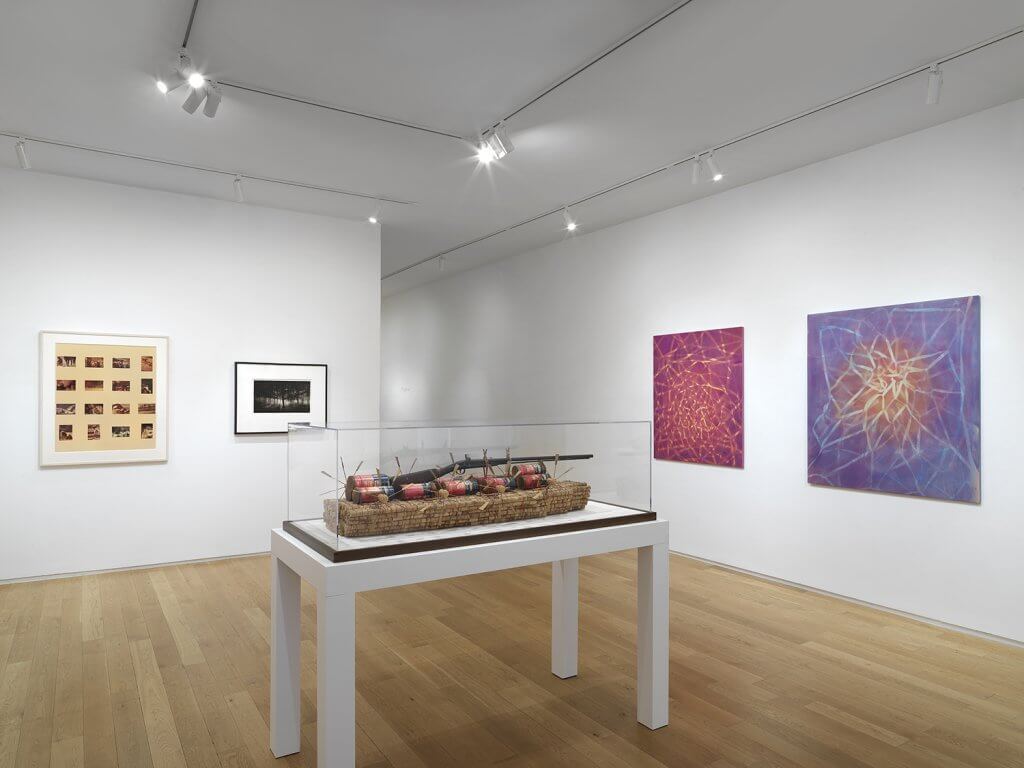
Installation view of Purpose (July 9-August 21, 2025) at Alexander Berggruen, New York.
Q: Would you like to discuss one other artwork in this group show that you feel especially invites a conversation with your work?
A: I was pleased to see Chris Burden’s The Ship O’ Corks (1983) positioned across from my painting Internal Bloom, particularly with the child’s gun pointed directly at its center. Beyond the obvious implication of violence, here the pointed gun invites a deeper reflection. I began thinking about Burden’s infamous performance Shoot (1971) and its intention to feel what has been seen. In contrast, the intention behind Internal Bloom is almost the inverse – to make what is felt seen. This arrangement made me reflect on how violence exists in my own work, and brought to mind a sensation during a near-death experience I once had – when my life seemed to flash before me, not through images or narrative, but through patterns. I sensed these patterns were a kind of childhood language – perhaps pre-verbal memories. For me, textile is a material language that carries these types of ancestral memories of pattern, language, and spirituality, and Internal Bloom is inspired by these deeply intertwined systems.
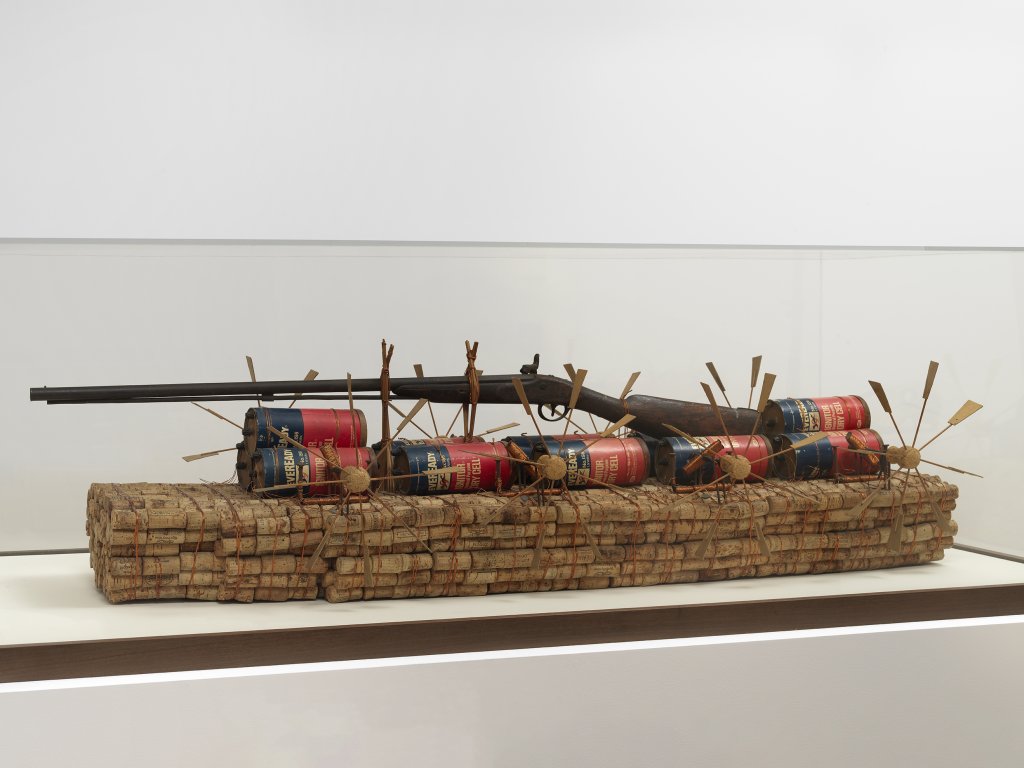
Chris Burden
The Ship-O-Corks, 1983
2,700 wine and champagne corks, copper wire, 12 dry cell batteries, wood, cardboard, child’s nineteenth-century shotgun, eight paddle wheels, bamboo, nails, and electric tape
12 x 54 x 12 in. (30.5 x 137.2 x 30.5 cm.)
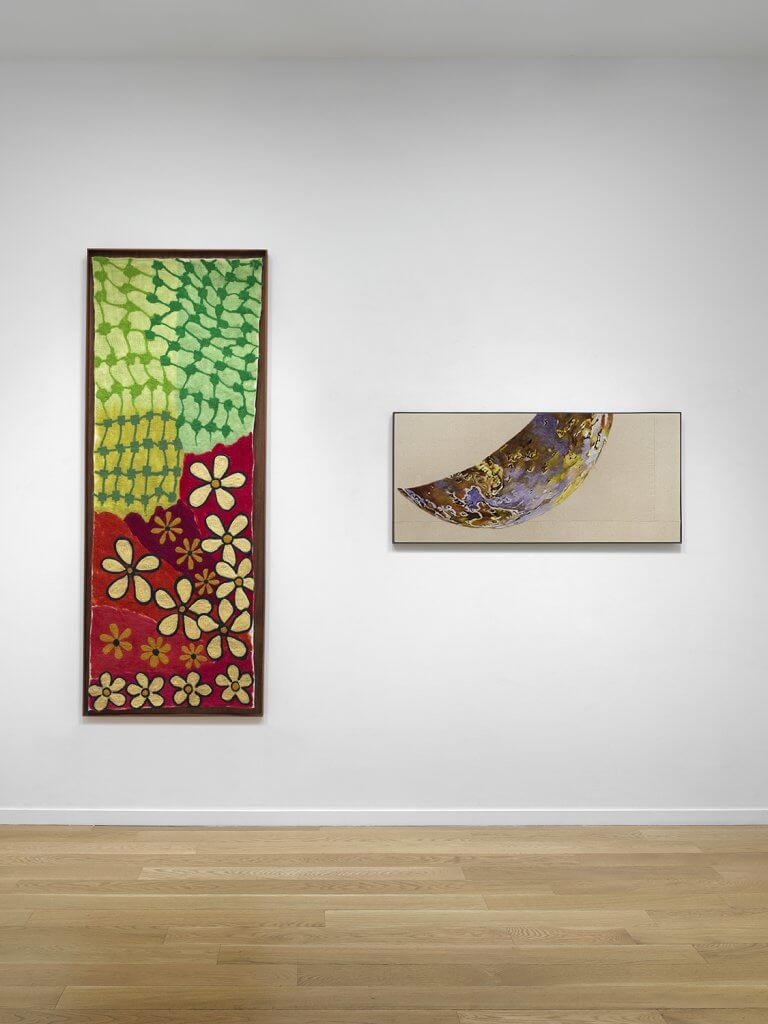
Installation view of Pauline Shaw’s works in Purpose (July 9-August 21, 2025) at Alexander Berggruen, NY.
Q: How is the felt adhered to the canvas? Could you describe your process of felting?
A: The process for the canvas works is needle felted (versus wet felting). I began my felting journey with wet felted works, which is a process of laying out fibers in alternating layers, then through heat (hot water) rubbing and soap, the fibers essentially form a flat knot. With needle felting, you are doing the same process interlocking the scales of the wool or silk fiber with the canvas. The process is done with specialized barbed needles that I make tools for to hold. The fibers get pushed thru and they interlock with the weave of the canvas. Normally, this process is done with only protein fibers, but sometimes I will mix vegetable fibers such as viscose, or bamboo silk into the works.
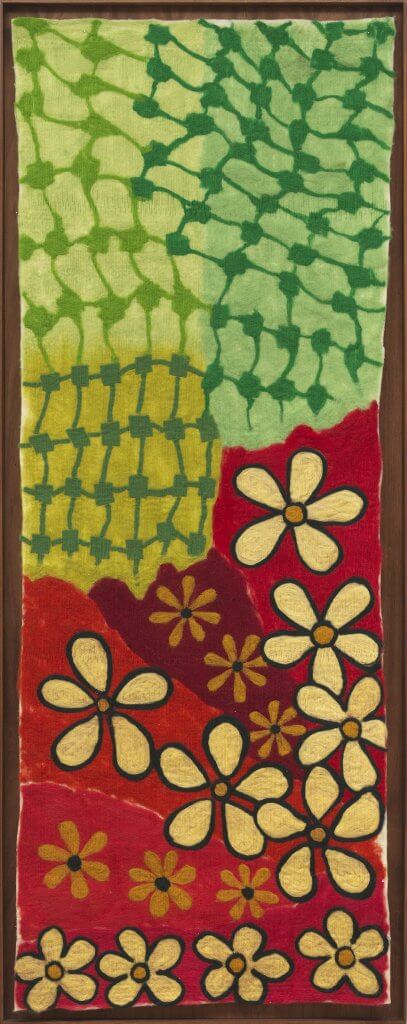
Pauline Shaw
Untitled (flowers), 2024
felted dyed wool in Tzalam wood frame
80 x 31 1/2 in. (203.2 x 80 cm.)
Q: Where did the inspiration for the imagery in Untitled (flowers) come from?
A: For Untitled (flowers), I was looking at archives from mainly The Met, as well as antique fabric dealer websites. Specifically, many of the items would be labeled as “scraps” or “piece of” which I found to be interesting as a remnant of a whole. I believe for flowers, the floral imagery came from a “piece of” applique banner originally from India. What I find interesting about sourcing imagery this way, is that many of these archived pieces will have a provenance attached to them, such as “might have been used in a wedding ceremony, etc.” so there is leeway for some amount of historical / museum fabrication involved, which points to how history and culture is recorded.
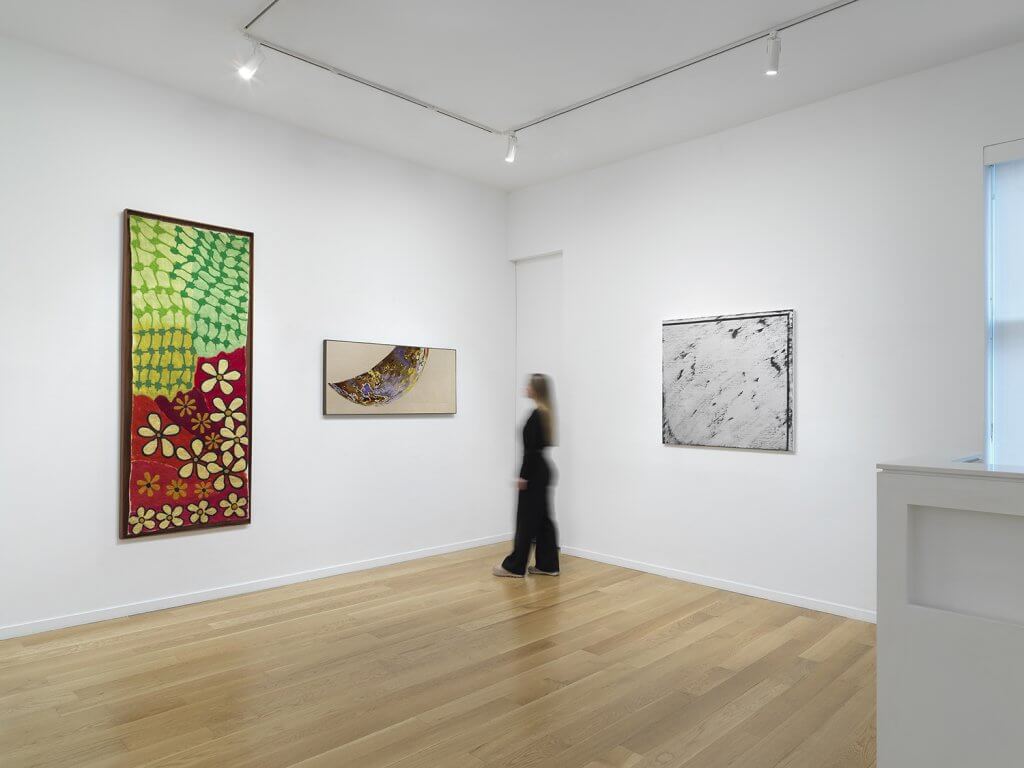
Installation view of Purpose (July 9-August 21, 2025) at Alexander Berggruen, NY.
Q: Would you like to discuss one other artwork in this group show that you feel especially invites a conversation with your work?
A: Jacqueline Humphries painting, and Rosemarie Trockel’s Studie zum Fleckenbild feel very in conversation with my work. Trockel’s practice of using an industrial knitting machine to create abstract works, critiquing the male-dominated and masculine status quo of the time. With Humphries painting, I find the imagery and surface of the painting to be visually very compelling and interesting next to my work Eclipse. The reflective quality of the painting surface catches the colors of Eclipse at certain angles, turning the silver into a purplish hue.
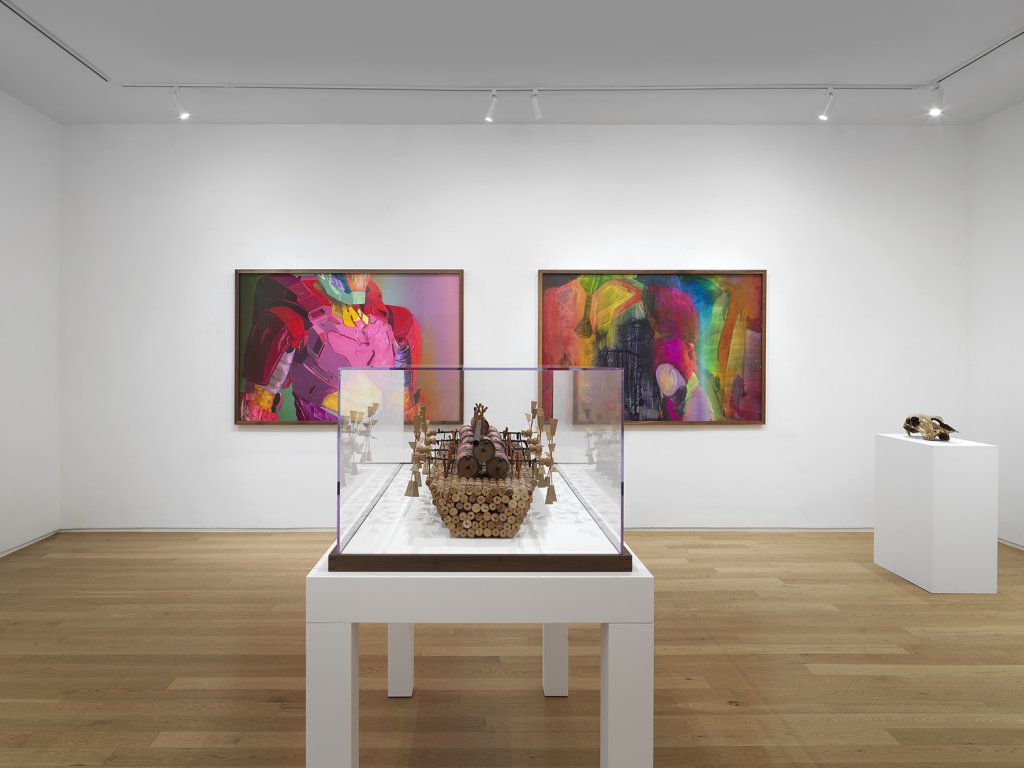
Installation view of Purpose (July 9-August 21, 2025) at Alexander Berggruen, NY.
Q: Would you like to discuss one other artwork in this group show that you feel especially invites a conversation with your work?
A: Sherrie Levine’s bronze sculpture Steer Skull, Un-horned
Often cited as an homage to the paintings of Georgia O’Keefe but simultaneously a fulsome celebration of all the contradictions embodied by the American West. The violent and destructive race to an abundant frontier, the fragility of a hyper-masculine vision. Castrated and dehorned yet preserved and polished as a trophy.
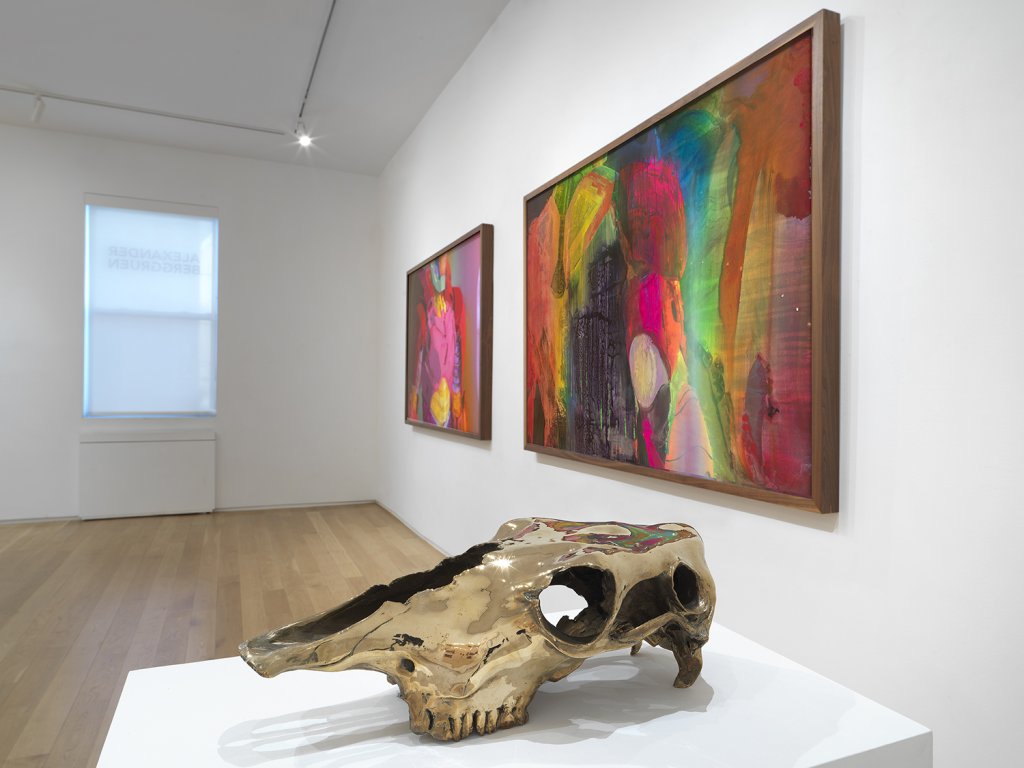
Installation view of Purpose (July 9-August 21, 2025) at Alexander Berggruen, NY.
Artwork and Installation Photos: Dario Lasagni